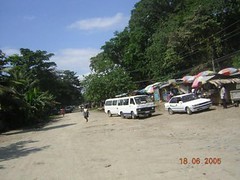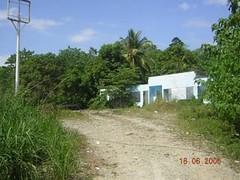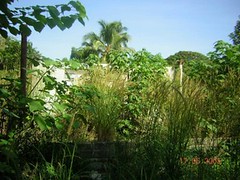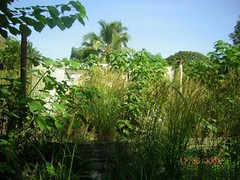
White River Market and Bus Stand.
Now after five years since the crisis that had led to some hundreds of people dead, and thousands homeless, what used to be the stronghold bunker controlled by the MEF, White River, has turned into a busy market place where people of different ethnic groups meet,mingle together and exchange produce for cash. The women’s initiatives during the tension period came about the setting up of an organization called Women’s for Peace which is responsible for the setting up of the permanent market centre for the people of Western Guadalcanal and those of the White River and neighbouring places in town and in the effort to maintain peace between the warring parties.

The remains of the once "Franks Refueling Station".
Leaving White River market, you would come across the remains of a refueling station that was burnt down during the tension period. This is Kakabona area, the place that suffered the most of the impact of the conflict on Guadalcanal. Almost all of the houses here were permanent houses that were burnt to the ground by Malaitan militia during an payback operation. However, after five years on, the tension left nothing to the people of the area, except for the remains of their burnt down houses with most of their life savings gone in flames. The people have still yet to come to terms with what they have suffered, as this conflict was brought upon them by those whose agendas differ from what these people here might have. Five years on they were still waiting for what the government have promised, although the property claims have been paid to these people according to the “committee” responsible; however, since then, the people here have never received their money for their claims to damages made to their properties and livelihood.

The remains of a house that was burnt down during the raids on Kakabona.
The people tried to rebuild their own lives by themselves, by living in makeshift houses and struggling to earn a living from whatever means they could get their hands on to feed their own families, since their property claims have been diverted to some few greedy individuals who have access to these money and then “coning” the poor people who have lost all their livelihoods and suffered the most during the sad era in the history of Solomon Islands
This then brings the issue of whether we ourselves were to blame for this sad saga that have been bringing us to the brink of economic collapse and nearly become a fail state. Whether we should blame the government of the day for the collapse of law and order in country, or whether we should blame our neighbours for turning a blind eye during the crucial period of our country?

Remains of a house at Kakabona.
All these are some valid questions that have crept up to the minds of the simple rural dweller in Solomon Islands, whose interests’ lies not in the economic or political nature of the country but on the immediate needs of the family and making sure that there is bread on table at the end of the day. These are the very people that have suffered during the height of the conflict and have still not received their claims for the properties lost; they are the ones still struggling for their voice to be heard and their pleas to be taken up the ladder of democracy. The elected individuals have not often been so helpful, most of the times their hands end up in the pockets of the rural dwellers for his or her own gains. Where then could we the grass roots could turn to? The donors’ funds always end up in the wrong hands and diverted to other use by the government and often claimed by reports to donors that the projects have been financially successful. The Rural Constituency Development Fund (RCDF) have been since independence have not been used for the development of the constituencies but rather for the development of the "consistency of the voters" to elect them in power.
This then are the issues that needs to be addressed by the government and people of the nation of Solomon Islands, it is then time that we people of this nation rebuild our lives upon the ruins of war and do away with corruption, it is time that we come forward and say enough is enough, let peace take its toll, and lets work together side by side and help our RAMSI friends fight corruption, crime and the gun culture that spoils our childrens' future.
No comments:
Post a Comment